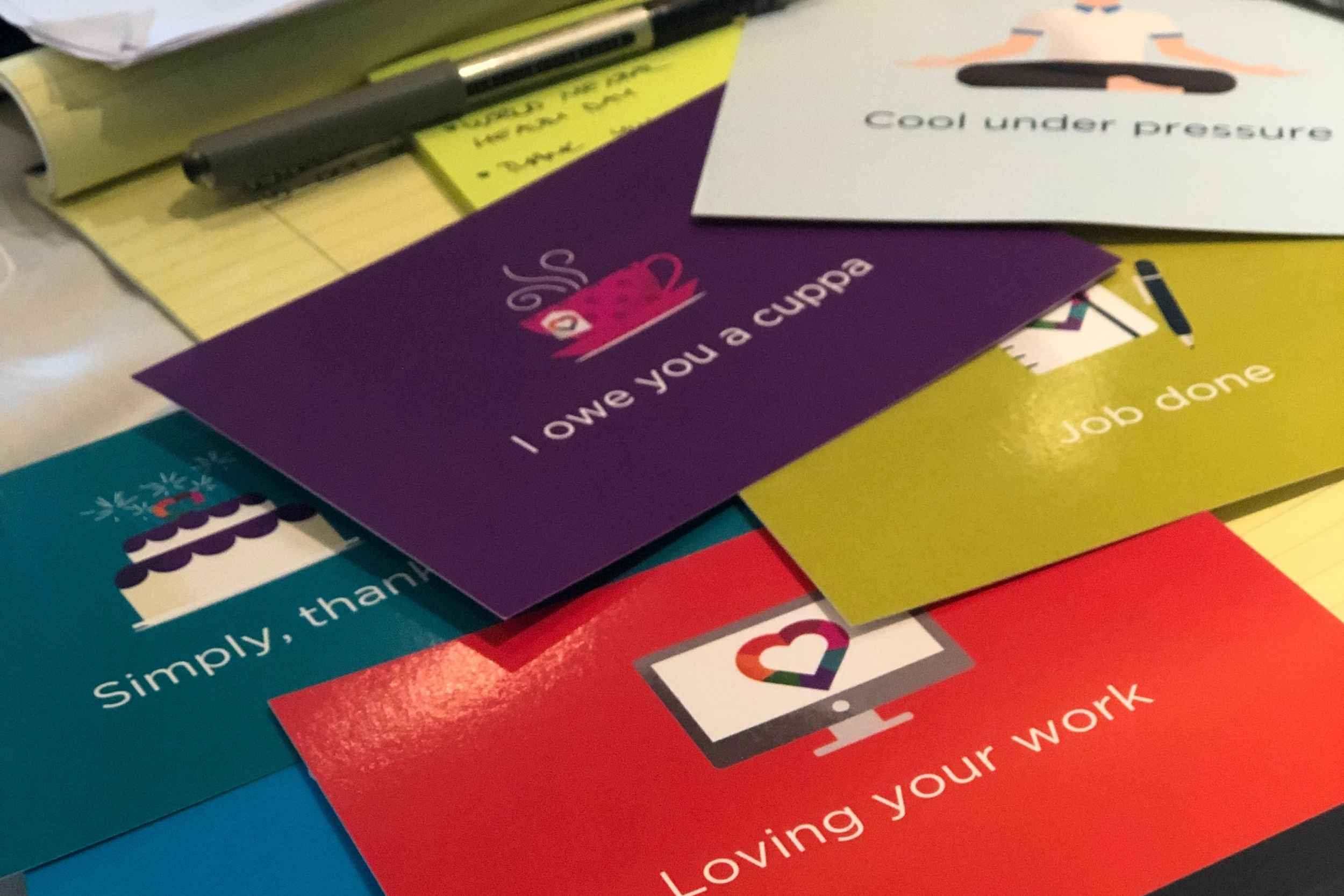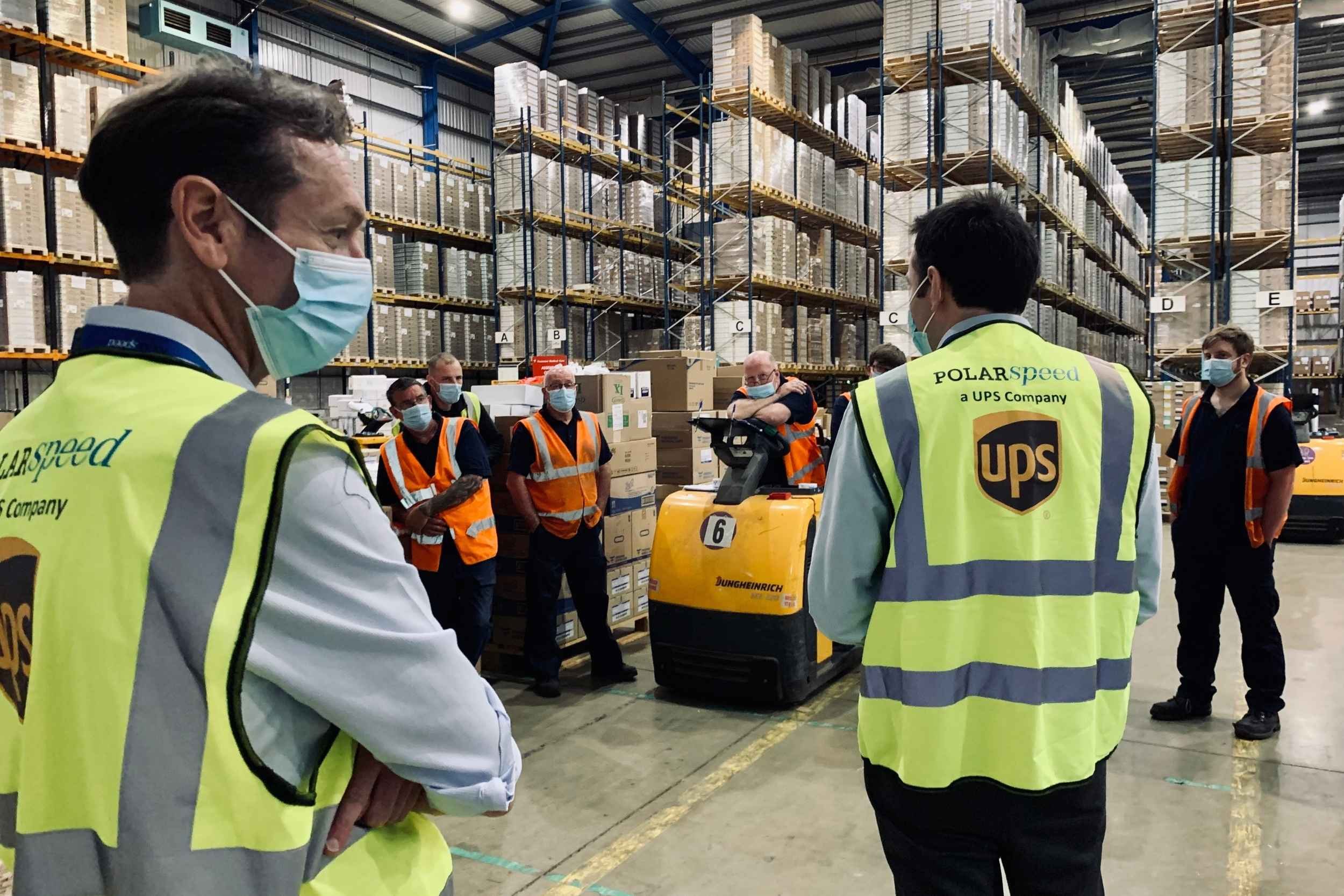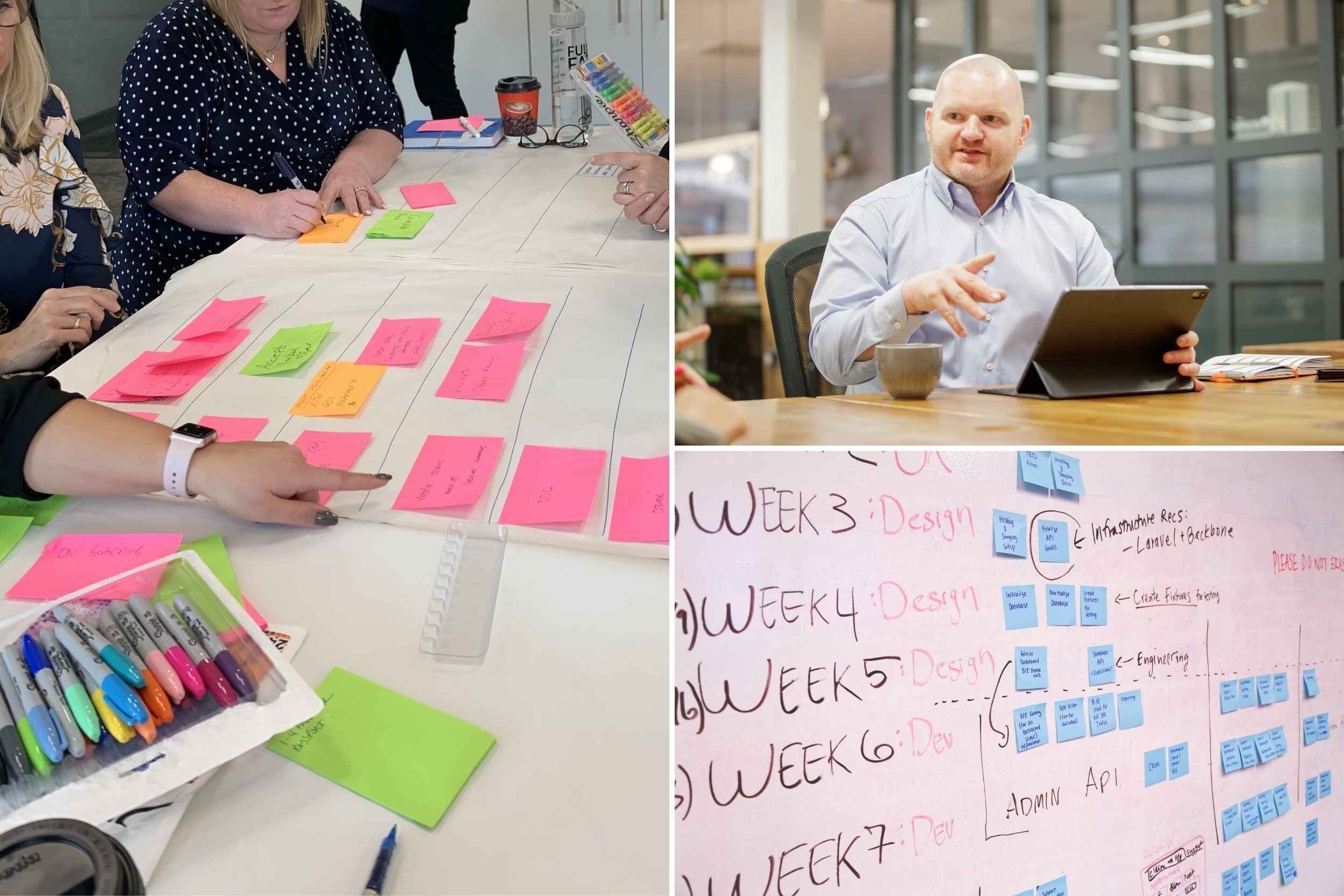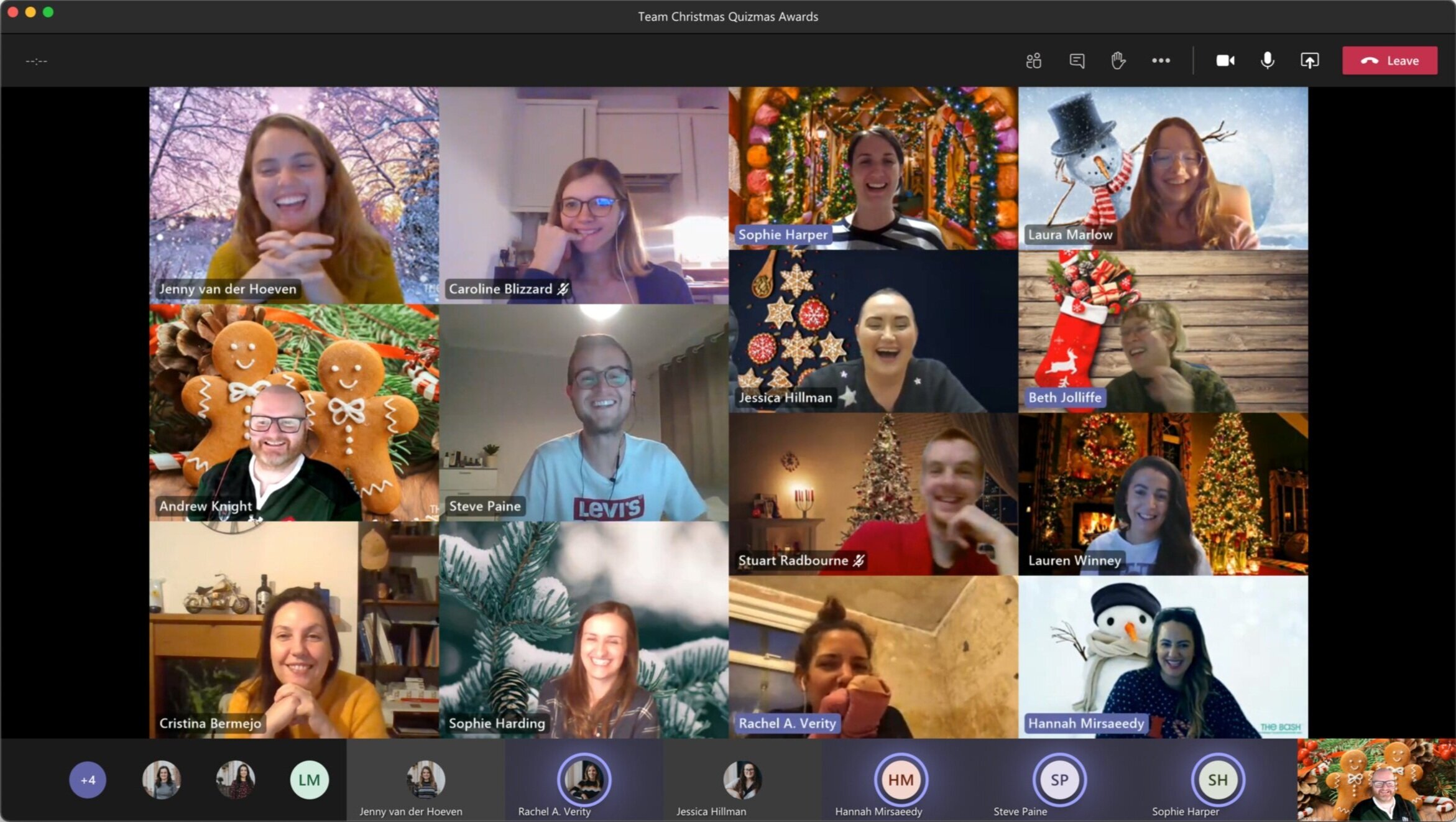Before the article, a word or two about Ukraine 🇺🇦 When I drafted the outline for this article a few weeks ago, I couldn’t have imagined that Russia was about to invade Ukraine. At that time the rolling-news agenda was dominated by #partygate, the Sue Gray report, the Met Police and the ‘toxic culture’ at 10 Downing Street. What a difference two weeks makes. Like many of you, I’ve watched the news in horror, bearing witness to this unfolding catastrophe through the reports of journalists and the messages from the brave people of Ukraine. And let’s be honest; from my position of relative comfort and privilege, ‘thoughts and prayers’ are utterly insufficient. If you want to do something to help, you can donate to the Disasters Emergency Committee Ukraine Humanitarian Appeal. By donating you’ll help DEC charities provide food, water, shelter and healthcare to refugees and displaced families. Also, the DEC Afghanistan Crisis Appeal remains open to respond to what the Head of the World Food Programme previously described as “the worst humanitarian crisis on earth”. I’ve decided to publish this article as planned, because an organisation’s culture and leadership are key to the resilience, productivity and success of its team. This is especially important at times of uncertainty and crisis, whether the cause is close to home and (potentially) controllable, or further afield and out of our control. So, what does your company culture say about you, how you manage uncertainty, and how you support your team?
Can you see what your workplace culture says about your business? Having a strong workplace culture can be a lifeline in times of pressure or stress. Internal strains aside, whatever’s happening in the world will have an impact on your workforce. Whether the pressures and stresses your team are feeling are as a result of Brexit, COVID-19 or a raging war, a working environment that feels psychologically safe is really important.
Prior to the Russian invasion of Ukraine, the ‘toxic culture’ of both Downing Street and the Met Police dominated the news for what felt like forever. Understanding that culture change is key in transforming an underperforming business is not an alien concept to many leaders. Most leaders understand the necessity of good workplace culture. The trouble is that even though we know what it means, it can still be hard to recognise what’s happening in our own organisations.
Most leaders don’t know how to objectively measure and assess company culture In this article, we discuss a few positive and negative indicators that you might recognise from your own business. Lots of positives means Sue Gray is never going to knock on your door…but more than a handful of negatives is a definite red flag. Think of your organisation as a complex web of different traits, habits, actions … ways of communicating. Johnson and Scholes mapped this out in their Cultural Web tool into six high-level categories, which we’ve unpicked here.
What are the positive signs that we have a healthy work culture? Let me be clear here, the perfect culture does not exist (sorry not sorry to the perfectionists out there). Whenever I work with clients on cultural change, I’m always on the lookout for positive signs of a healthy culture. Some indicators will be subtle, and some are glaringly obvious. You might have a handle on the formal culture across the business but find gauging the informal culture is much harder.
Formal indications of a healthy work culture • Control Systems – colleagues accept responsibility to support and develop others. Balanced decision-making is valued. Information is shared transparently, with no mind games! • Organisational Structures – teams work collaboratively. Purpose and strategy are clear to all. Learning from failure is encouraged and there is space to make mistakes without unfair reprisals. • Power Structures – clearly delegated authority. Leaders are open to (and seek) challenge. Teams tend to be self-managing. There is a high-trust environment.
Informal indications of a healthy work culture • Rituals & Routines – culture of learning and nurturing talent. Customers at the heart of all decisions, inclusivity beyond legal requirements. • Symbols – success and failure leading to innovation is celebrated. An informal hierarchy. Strong, organised internal communication tools. Leaders shape culture through their actions. • Stories – no rumours or gossip (ok, minimal rumours or gossip), all information is shared, listening is valued, clear guidance on how conflict is managed.
What are the signs that our culture isn’t doing us any favours? Reminder: the goal is to check the health of your company culture and it would be weird if you didn’t come across some negative indications, so please try to be open to them. If you notice one-offs from the list below that might not mean you’ve got a problem; after all, none of us are perfect, right? But lots of negatives are a red flag and indicate you’d benefit from digging a little deeper. So take a deep breath… and dive in…
Formal indications of an unhealthy work culture • Control Systems – areas of the business where ‘management’ is feared. Sales or performance incentives drive inappropriate behaviour. Processes are side-stepped with workarounds. • Organisational Structures – business units operate in silos or with minimal collaboration. Diaries are overloaded with meetings. Promotions are decided based on who you know. • Power Structures – leaders make unilateral decisions without adequate consultation. Information is managed on a ‘need to know’ basis. Challenge is absent, discouraged or simply ignored.
Informal indications of an unhealthy work culture • Rituals & Routines – communication is a one-way street. Leaders broadcast messages and employees are told to leave their personal life at the door. • Symbols – there are unwritten rules about teams, people, or places to avoid in the business. Some teams are higher in the pecking order than others and burnout is a badge of honour. • Stories – whispers of toxic behaviour tolerated from high earners or top performers, managers ‘throwing their weight around,’ gossip about leadership conflicts.
If you only come across negative indications…take a step back and check your own blind spots (and biases)! If you recognise some of these points, consider whether your team feel psychologically safe enough to raise them with you themselves? Having a working environment that allows people to feel comfortable speaking truth to power is a vital part of a healthy company culture.
It is challenging, but possible, to assess your culture from the inside. There are lots of tools available to assess culture and there are simple things you could try and implement straight away to make your place a better place. Here’s a link to my list of 10 proactive and pragmatic things leaders can do immediately to influence company culture, split into organisation-wide, team and individual actions.
Invest in your culture If you’ve read this far you know it matters! Assess how you can do better – happy, healthy, profitable businesses put aside time and effort into nurturing a positive culture. Assessing your culture needs a coordinated approach and, particularly in a large business with lots of divisions, it may feel like a daunting task.
If it’s too much, an external consultant might be a worthwhile investment. It’s more cost effective to pay an HR expert to do it right first time, than getting an internal team to struggle with it over a longer period. A fresh pair of eyes will often see more when it comes to diagnosing cultural problems and will be able to help you create a plan of work to implement and manage change.
Choosing the right HR Consultant (and get a return on your investment) Your organisation’s culture and values are essential to your performance and success, but how do you measure them? If you aren’t sure where to start when it comes to a culture review or diagnostic; or if you’re ready to make a positive change to your organisation’s culture, values and performance, I’d love to hear from you. Get in touch for a friendly chat about how I can help.

Control Systems
Organisation Structures
Power Structures
Rituals & Routines
Symbols
Stories

Culture can be subjective but you can objectively assess the formal and informal elements in your workplace
If you only come across positive indications…you’re not looking hard enough!

None of us are perfect, but if you notice lots of red flags, it’s time to dig a little deeper

“Andrew at The Spark Company is a great partner for a business to work with. He combines a practical, no-nonsense approach with good technical knowledge and quickly builds a rapport with existing teams to hit the ground running”.
⭐️⭐️⭐️⭐️⭐️ Google Review
Category: Blog
10 proactive things leaders can do now to influence company culture
It is challenging, but possible, to change your culture. There are lots of tools available to assess culture and there are simple things you could try and implement straight away to make your place a better place.

I’ve pulled together 10 straightforward and pragmatic ideas for leaders who want to improve workplace culture. It’s time to get stuck-in with some practical and actionable things that you can do in any organisation.
I’ve split these actions into organisation-wide, team and individual actions. It’s best practice to hit all three levels to give your culture change a chance to stick.
But before you start, imagine your organisation as a complex web of different traits, habits, actions … ways of communicating. If you really want to get under the skin of what’s going on, check out our article on company culture blindspots and make sure you’re not missing something crucial to your team’s success.
Your organisation is a complex network of different traits, habits, actions and ways of communicating
Things I can do as an individual to improve company culture
• Articulate your vision – Clearly explain what your vision is, get the senior managers onboard and create a plan to communicate across the business.
• Live by your values – Make sure your decisions align with the values of the organisation, both in good times and tough times. Personally demonstrate the business values every day.
• Talk to your customers – Find out what your customers really think of you. Using an external consultant here can encourage a customer to speak more freely and give honest feedback.
Things I can do as a manager to improve company culture
• Analyse all available data – Gather statistics that reflect how your culture is impacting customers and staff. Consider: customer complaints, Glassdoor reviews, Trustpilot reviews, attrition rates/absences and staff complaints.
• Listen to your team – Spend time with people. Visit the shop floor. Be seen. Be approachable. Get to know your staff and ask them what their experience of the business is.
• Recognise how COVID-19 changed how teams work – How has hybrid working during COVID-19 impacted team culture? Avoid ‘forced fun’. Consider scheduling people to be on-site at the same time, so they can work together naturally. Online collaboration time can be as helpful as blocking-out time for deep and meaningful work.
• Monitor workload & set boundaries – Make sure that everyone has an equal chance of success, time to meet customer expectations, and sufficient down-time. Consider a ‘no video meeting day’ each week, to allow space to focus.
Things I can do across my organisation to improve company culture
• Survey your team – When did you last benchmark how people are feeling? You could survey all your staff to see how they are feeling about the organisation post-pandemic. (Maybe a statement of the obvious, but only do this if you have bandwidth to analyse the results, listen to what you’re being told and crucially, do something about it.)
• Review your organisation design – Has any unfairness crept in due to remote working during the pandemic? Have you buried problems by some people not being physically present? Is everyone clear on who their manager is and who they go to for help?
• Improve internal communications – Check your communication channels work and reflect your company values. Are you sending a weekly newsletter into a black hole? Are people engaged? Is it 100% broadcast or is there interaction? If you are getting interaction, does everyone have a chance to join in?
Quick fixes won’t create a lasting and positive culture
Invest in your culture
Why bother investing in company culture? Well, it’s no coincidence that happy, healthy, profitable businesses put aside time and effort into nurturing a positive culture. Let’s be clear, this is a conscious choice that leaders make to invest in a positive, inclusive and productive workplace culture. It doesn’t have to be difficult but culture change does have to be planned and coordinated.

Taking action, particularly in a large business with lots of complexity, may feel like a mammoth task. This is particularly true if you’re not sure where to start.
Company culture is a bit like health & safety, compliance, safeguarding, etc.; it’s everyone’s job to develop and grow a positive workplace culture, but it starts with you. Leaders set the tone.
If the idea of cultural change is too much, an external consultant might be a worthwhile investment. It’s more cost effective to bring in a HR Consultant to do it right first time, than asking your team to try and pull together a plan for culture ‘off the side of their desks’ (and usually over a longer period).
Positive culture doesn’t just happen. Bring in an expert to get things moving and upskill your team
Depending on your workload and available resources, I’d always suggest allocating someone specific to lead on cultural change, whether this means bringing in an expert to work alongside and upskill your team, or giving someone a secondment or project opportunity. That way you’re getting focus and energy in the right place, and developing your own in-house capability at the same time.
However you do it, it’s all about enabling you to take control of your own cultural destiny and not being ‘done to’ either through inertia or reacting badly to events because your culture isn’t resilient or flexible.
I want to make positive cultural changes, but I need help getting started…
It can be daunting to get started, so you might need an experienced and knowledgeable HR consultant to assess your culture and create an action plan.
As a specialist in organisational change I love to get stuck-in and support clients to make positive changes in the workplace.
Get in touch for a friendly chat about how I can help.
Help! I need to resolve a complex grievance without bias or prejudice. It’s time to bring in an expert.
An independent grievance investigation can help you stop an employment tribunal claim in its tracks. Here's how:
Most of us know that in the long run, not addressing a problem that's perceived to be our fault is a bad idea. We may think we've done nothing wrong, and may disagree with the accusation but not talking about it doesn't make it go away. It's the same in the workplace.
When a problem emerges, failure to act can lead to an employment tribunal (very expensive) decreased staff morale (increased attrition rates) and damaged reputation (decrease in profits). Somewhere between a small problem and full-blown employment tribunal is a formal grievance, that needs to be investigated.
Can’t I just sort it out myself?
Initially you may have tried to solve a grievance yourself. Perhaps it started as an informal complaint or discussion which then escalated to something more significant.

Once a formal grievance has been made then it may become impossible to deal with internally. Sorting it out yourself only works if you can find somebody to conduct a confidential investigation that is totally impartial.
In this blog post what you can expect and why it’s worth avoiding the eye-watering costs of an employment tribunal.
You cannot be impartial or fair, if you investigate a grievance that you’re involved in
However far removed the investigator is from the complainant if they are part of the same business, or closely connected to the business in some way, it’s difficult to see how they can be totally unbiased. Impartiality is one of the most important considerations when conducting a grievance process.
What if things have become really awkward?
Let’s be frank; your main objective should be to resolve the situation amicably and acknowledging if you’re at fault. That means dealing with any misunderstandings that might have occurred and definitely saying sorry and putting things right, if you’ve done something wrong.

Even if you're 100% sure that you've done nothing wrong, it's good to keep an open mind and focus on a positive resolution.
It might be difficult to continue working with someone who has raised a grievance, but don't let that stop you from doing business and serving your customers.
If you’ve done something wrong, say sorry and put it right as soon as you can
It takes resilience and integrity, but you'll get through this. Raising a complaint and submitting a grievance is a big deal, so despite any misgivings you may have, try to bear in mind that your colleague/employee is probably feeling awkward too.
How should I choose an independent investigator?
If you're tempted to conduct an investigation using internal resources, it's worth bearing in mind that biases or individual concerns may prevent enquiries from being carried out fairly, particularly in those tricky cases when senior team members are accused of wrongdoing.

There are a handful of common-sense checks that you can carry out before you choose an external and independent investigator.
You’ll need to be able to trust them implicitly because you’re not going to learn what’s been said until the end. You should also take steps to make sure they’re not connected to your business or complainant.
You can ask for references or speak to previous clients, without breaching confidentiality (of course)
Top tips for choosing and commissioning an independent investigator:
-
Do your research, thoroughly – Check their qualifications credentials and experience. Ask if they've worked in your industry or sector before, and whether they've had experience investigating a complex grievance in the past. I often find that out-of-sector experience can be an advantage and give me an edge when I'm interviewing witnesses and weighing evidence; it gives me a broader range of comparison.
-
Share the full story to date – Give the investigator a summary of the case, including anything that may have gone wrong in the lead-up to the grievance. You'll be dealing with a complex case by this point, so you may not be able to share everything until you've selected an investigator. When I'm being considered for a grievance investigation, I'm happy to sign an NDA or confidentiality agreement if needed.
-
Give clear terms of reference – Once you've chosen your investigator, you need to give them a proper brief. The most practical way to do this (and comply with the law) is to issue terms of reference. When I'm working with clients, the terms of reference are invaluable. The terms of reference tell me what I'm looking into and stop me from straying into unrelated areas.
-
Keep your nose out – Once the investigation gets going, the best thing you can do is keep your nose out of it! Don't ask for updates about what's said at each interview, you have to let the investigation run its course. When I'm investigating a case, I always keep the commissioning manager informed of my progress, without discussing the detail. It's important to keep managers informed, so that the grievance investigation doesn't interfere with the day-job.
-
Trust the process – Make sure you understand the process and the timescales at the outset. You need to be comfortable with when, where and how the investigation will take place, so that the process is fair and proportionate, but also so that it happens at a reasonable pace. When I'm investigating a grievance, I have a clear plan which complies with ACAS guidance. It's designed to make the investigation as quick and easy as possible for everyone, and to avoid negative effects on the complaint, manager and the business.
-
Allow access to information and people – Don't be surprised if your initial witness list and evidence changes during the investigation. If other people are implicated as witnesses or even potential victims, be prepared to allow the investigator to talk to them without asking why. You might find that it's hard not to be curious and concerned. I always flag if there's a safeguarding, regulatory or legal concern that might affect the business, so you'll know if you need to act immediately to prevent harm or reduce risk.
-
Be open minded – By the time we get to an investigation, a lot of bad things have been said and there may be bad feeling. Don't presume one party is guilty and another is innocent until you have the report. You may be treading on eggshells, so I always advise clients not to do anything that might sway proceedings, but also, not to be afraid of managing their business 'as normal'.
Doing a proper investigation and sticking the process helps to protect you
Remember, investigating a grievance properly and sticking the process, helps to protect you should for any reason the grievance end up in legal proceedings. You will have to demonstrate that you followed all the rules, including your own internal policy, and that you carried out a fair and impartial investigation.
“I can't recommend Andrew and The Spark Company highly enough. He helped me to resolve a tricky and confidential employment issue; gave me pragmatic advice and supported me all the way.”
⭐️⭐️⭐️⭐️⭐️ Google Review

What will a good impartial investigator do?
There are some situations in the workplace that are best approached confidentially and objectively. Grievances are top of this list.
You might feel nervous about the prospect of a stranger coming into your team and asking lots of questions. As with any relationship, don’t be afraid to set ground rules and agree clear expectations. This will reassure you and give you confidence.
An external investigator should reassure you, remain objective, and carry-out a thorough investigation
8 ground rules for an independent investigator:
1. Conduct an unbiased, expert investigation – Hiring the help of an independent specialist gives you reassurance that the investigation is being carried out without bias or prejudice. This might seem like something straight from the Ministry of the Obvious, but independence brings scrutiny and credibility.
2. Gather all the facts at the outset – Most investigations begin with a scoping call to outline the nature of the investigation and other details about the assignment, such as duration. This is followed by confirming the terms of reference and reviewing any documents and evidence that may be required.
3. Stick to the brief – If it looks like the scope of the investigation needs to be widened, this shouldn't be done without consulting the commissioning manager.
4. Interview the complainant and review evidence – The next step involves meeting with the complainant and relevant witnesses, taking notes of meetings and reviewing any additional documents or evidence. This can be done face-to-face, virtually, or both. As new evidence comes to light, it may be necessary to re-interview some individuals. Decent investigators consider both the context and the facts being presented. It's important to understand what was going on at the time that an action was taken, or something was said.
5. Share progress about the process not the person – They should keep everything confidential. They may undercover lots of thorny issues which needs to be properly untangled. Staying connected with the commissioning manager is important, but don't expect the investigator to breach confidentiality or give you hints about what is said whilst the investigation is ongoing.
6. Understand what's illegal vs what's bad practice – The only time that an investigator should share something mid-way through the process, is if they find something serious or illegal that means they have a duty to act. For example, an ongoing safeguarding issue. It's important that the investigator understands when they have a duty to act.
7. Protect employees that may be vulnerable – In some cases, the complainant may be frightened. The consultant should be experienced enough to instigate a process that is appropriate. For example, a meeting with a complainant about a manager who they've accused of bullying them, might need to take place off-site. A good investigator anticipates these issues and should support you to look after the well-being of those involved… grievances are incredibly stressful.
8. Give a comprehensive report at the end – When the investigation has concluded, you'll receive an investigation report that includes a list of all evidence considered, witnesses interviewed, findings, recommendations and suggested next steps. If follow-up meetings are required, these can also be arranged.
A thorough investigation is also an opportunity to identify what’s going well and how you can improve
Most employers appreciate it when an investigator identifies lessons learned and ways for the organisation to improve. It's easy to be critical with hindsight; the best investigators will prepare a considered report, offering constructive criticism and highlighting where things went right, as well as missed opportunities to get things 'back on track'.
A de-brief including lessons learned is something that I offer as a standard; after all it makes good business sense to use your investment in an external investigation as a catalyst for improvements in the workplace.

Why is it worth getting right?
Failure to investigate competently could lead to further complaints or even an employment tribunal claim, it makes better sense to hire an external confidential investigator – someone who can carry out the process in a balanced, objective, and efficient manner.
When you take a look at the number, the potential costs to a business of defending a tribunal claim are eye-watering.
Compensation awarded in employment tribunals can be huge. Just look at these pre-pandemic numbers:
Average compensation of £10,812 and a maximum of £118,842 for Unfair Dismissal
Sex Discrimination cases paid out £17,420 on average with a maximum of £73,619 in one case
Pay attention to age-related bias; £38,794 average and £243,636 maximum for Age Discrimination
The maximum pay-out in Disability Discrimination case in 2019/20 was a whopping £265,719
But wait, these figures don’t include legal fees, lost productivity, management time, or the cost of time away from your customers
Source: Ministry of Justice 2019/20 Tribunal Data
Many business leaders worry about the possibility of an employment tribunal…and with good reason. But when it comes down to it, as a leader you are expected to do what’s right, fair and within the law, every day. This means balancing the needs of your business, your team, your customers and external pressures on a daily basis. Not everyone will like what you do and it takes courage to make tough calls.
An open and positive workplace culture ultimately pays for itself; creating psychological safety and enabling your team to raise concerns quickly, informally, and without fear of repercussions. The result? Issues don’t fester and the risk of employment tribunal claims is reduced.
Remember, there are alternatives to formal grievances, including informal resolution and mediation
If a colleague submits a formal grievance, I always encourage managers to seek an informal resolution if at all possible. It’s better for the health and wellbeing of everyone involved, it helps you get back on track more quickly, and let’s be frank…it’s a better use of your time and resources. (In fact, I’ve worked with several organisations where a mutually agreed resolution has transformed a disgruntled colleague into an advocate.)
But when those tricky cases crop-up and you need to formally investigate a grievance, it pays to make sure that your process is fair, objective and thorough. Given the legal costs, potential compensation, and risk of reputational damage, it’s well worth the investment in a top-notch independent investigator.
“Andrew’s support and advice has undoubtedly saved us tens of thousands of pounds in legal fees, let alone the amount of time and energy we would have wasted on a legal battle. Bringing him in was definitely the right decision”
Source: Confidential HR Investigation client (2020)
Choosing the right HR consultant for confidential HR investigation
If you’re looking for an experienced and knowledgeable HR Consultant to conduct a confidential investigation or have any other concerns relating to the people and culture of your organisation, I’m here to help.
As a police-trained investigator with many years’ experience carrying out investigations on behalf of clients, I’m well-equipped to support you.
Get in touch for a friendly chat about how I can help.
HR myths busted: “You can ‘Lift and Shift’ an organisational structure from one business to another”
If you’re looking to make a change, it can be tempting to try and transplant or improve upon an example that has worked brilliantly for another organisation. Amazing examples that get a mention on a podcast, or in a book can be thought-provoking and provide ideas but ‘lifting and shifting’ a design from one organisation to another rarely works, because just like you, your organisation is unique.
Having said that, there are four broad ‘types’ of organisational structure that you may have heard of, which are useful to understand.
‘Lifting and shifting’ an organisation structure rarely works, because your organisation is unique

The Four Organisational Structures
There are four types of organisational structures that can be seen across most organisations: Function, Product, Geography and Customer.
These four archetypes are the building blocks that organisations typically use when they’re (re)designing and (re)structuring their teams.
There are pros and cons to all four structure types and in reality, you’ll probably see a blend of the different types of organisation structure in use in your workplace today.
There are four types (or archetypes) of organisational structure seen in most companies today
- So you’re probably wondering how are the most successful organisations structured?
- What’s the ‘secret sauce’ for a great organisation design?
- Where should I start if I’m thinking about restructuring my teams and my business?
- Which of the four archetypes is most effective?
- Well, that depends on what you’re trying to achieve…

Functional
Functional structures organise and group work together by common activity.
In a functional structure, each function within the organisation is a separate ‘entity’ that is managed vertically by a Head of Function or Chief Officer.
Functional areas are sometimes referred to as “silos”. Communication generally follows the reporting lines (or hierarchy) of each function cross-departmental communication is usually handled by the department heads.
Functional structures organise and group work, and therefore teams, by common activity
- Functional structures work well when you’ve got a single line of business but can be challenging when you grow your product/service portfolio as nobody has end-to-end responsibility for product/service.
- When the work teams do is sufficiently specialised, functional structures can create efficiency and allow teams to focus right in on what they’re great at.
- When communication between departments can only be achieved by sending messages up the ‘chain of command’ to be passed at a senior level and cascaded down in another function, this can create blockages, duplication and barriers to productivity.

Product
Product organisation structures will group work by division, category, sector, or business unit.
In a product or divisional structure, it’s unusual to find any overlap between divisions. Typically, divisional leaders have high levels of autonomy and do not need to coordinate activity with other teams.
This usually means that each division is ‘self-contained’ and has its own resources to support that product line, e.g. its own marketing or product development teams.
Product structures are often organised as ‘self-contained’ and autonomous teams
- Many large corporations and multinationals have a multidivisional format, trading through subsidiaries and using the parent company’s brand name and/or intellectual property.
- Whilst subsidiaries or divisions benefit from the investment in branding by the parent company, it can be challenging to maintain consistency across each ‘self-contained’ or autonomous team.
- Sub-cultures can also be an advantage when well-managed, allowing for inclusion and expression, but can cause damage when allowed to diverge from an organisations core values, purpose, vision and mission.

Geography
Geographic organisation structures will group work by, well, geography!
In a saturated market this might look like an area or regional structure. In new markets, teams may be grouped together by country or territory.
Core products/services may be standardised but geographic teams are empowered to make decisions based on local culture, politics and tastes.
Geographic teams are, well, organised by geography, and usually empowered to make localised decisions
Geographic structures take many forms including satellite offices, websites and offerings tailored to local markets, and area/regional/country/global headquarters. In short, anything to stay close to customers.
Geographically dispersed teams can react more quickly to local events, cultural shits, political changes and the evolving tastes of their customers. Ever noticed that some soft drinks taste sweeter or more bitter in other countries? That’s a great example of a geographic team making a local decision to suit the market, whilst maintaining the core product offering.
Sometimes a geographically distributed team can duplicate resources and effort; I’ve even heard of three teams at one company all working on the same project without anyone realising. Without really top-notch employee engagement and internal communications, the business can end up competing against itself. This has the potential to mix messages for clients, and possibly create waste and inefficiency.

Customer
Customer structures will group work by prioritising the customers’ need for a single point of contact.
It’s fairly common to see customer structures when organisations group activity towards customers with similar buying behaviours.
If you ever meet a sales representative, account manager or customer relationship manager, the chances are that organisation is using a customer structure. It’s nice to know that they’re organised around your needs, eh?
- But a customer structure isn’t just for organisations with a product or service to sell. Many not-for-profit organisations and social enterprises offer services for clients with similar needs
- Having a single point of contact (often through a caseworker, community officer or advice service) means that customers have consistent contact with someone who can help them with everything. It’s a one-stop-shop built around the needs of the client.
- There are drawbacks to customer structures, particularly if the relationship deals with sensitive issues, such as social support services or relationships with vulnerable clients. The customer often sees the person delivering services as ‘the company’ and any changing of the guard can often have a negative impact on clients.
Customer structures organise teams by the need for a ‘single point of contact’ or common buying behaviours
- Many healthcare professionals also operate within a customer structure, e.g. your local GP. When you see a make an appointment at your local health clinic, you’re getting access to a range of general healthcare options via a single point of contact. Specialist care is provided elsewhere and referrals are based on ‘customer’ need.
- On one hand the customer structure enables a necessary triage and diagnostic service, on the other hand it creates a blockage and potential ‘gatekeeper’ for patients to ‘satisfy’ before accessing other services.
- Human nature being what it is, if you can’t get to your GP or indeed if you don’t want to wait for an appointment, it’s tempting to work around the triage system and use another access point (in this case, A&E).
- Perceived inflexibilities for service delivery and issues with capacity, ultimately result in pressure elsewhere in the organisation. Great communication and prudent capacity management are key.
Don’t know where to start when it comes to supporting your team through the Cost of Living Crisis?
We are passionate about finding ways to help bosses do the best they can to look after their people.
Some of what we’ve outlined here is simple, but implementing activity that’s targeted to help those that need it most often gets businesses in a pickle. Primarily because they get bogged down about treating all employees the same.
If you need help to work how to support those that need it in a way that’s fair and legal, then please drop us a line. We’d be happy to talk to you.
Mergers and Acquisitions: How to Spot and Avoid Culture Clashes
There are rules for all the legal bits of a merger or acquisition process, yet there is no bible or handy instruction manual for the successful transfer or integration of company culture.

What is workplace culture?
There is no magic formula, but regular and meaningful is a good rule of thumb.
Workplace culture is your way of doing things, your approach and style of business. It’s the difference between ‘my door’s always open’ and ‘make an appointment with my PA’. It’s often tricky to explain but culture manifests itself through leadership style, how you treat your customers and colleagues, and the diversity of your workforce.
Culture can be seen in your people, personality, structure, purpose and values.
How can culture impact M&A?
An unforeseen culture clash creates an uncomfortable, disengaged work force.
If people don’t understand the values and objectives of the newly merged business they will quickly retreat into the familiarity of the old. This can slow down the integration of departments and operational systems. It also compromises customer service and sales if frontline colleagues don’t understand what kind of messages they should be communicating.

Every successful merger and acquisition has a plan to retain key talent and avoid an exodus
- Everyone’s talking about the great resignation at the moment, so it’s more important then ever before to have a plan for engagement, talent and culture. Especially if your acquiring a business or merging two organisations together.

How can I assess the culture of my acquisition?
It might be tricky to really get under the bonnet of your acquisition in advance of the legal transfer date. Certain information around TUPE, finances, compliance and commercial integration, are accessible. But when it comes to engagement and culture, you’re not going to be able to hover around the water cooler or join a team meeting to gather intel!
If you’re using an independent HR consultant to help you navigate the legal aspects of your merger or acquisition this can also be a great way to assess potential pain points and plan for the challenges ahead. An independent person may gain more access to the company being acquired and can help you learn more about the people you’re bringing in.
What clients say about our approach to M&A
“He did all the detail but he was also great at creating relationships. So whilst we were getting all the paperwork and legal stuff in place, he worked really closely with the individuals that were going to come into the business to build trust with them.”
Heyley Selway
Chief Executive, CCHA
“Studies from the Queens School of Business and the Gallup Organization showed that organizations with low employee engagement scores experienced 18% lower productivity, 16% lower profitability, 37% lower job growth, and 65% lower share price over time.”
Emma Seppälä & Kim Cameron
Harvard Business Review
Why does culture matter?
Clearly defined culture is a sign of a positive, engaged workforce, which means exceptional customer service, confident sales and marketing, increased productivity, reduced staff turnover and a better share price. Why? Because when everyone is working towards a shared vision your people are an amazing asset. When they don’t feel part of the bigger picture they switch off, and can do some serious damage.
Try to understand what the cultural differences are between the old and new company. Nip any opportunity for a ‘them and us’ dialogue to take hold with a clear communication plan that’s put into action pronto!

An engaged workforce is more profitable – can you afford not to think about culture?

Do leaders know how to promote positive culture?
If people are used to being managed in a certain way it can be deeply unsettling when a new regime comes along. One of the best ways to establish your organisation’s culture and ethos early on, is for management to get out on the shop floor and talk to people.
As a minimum, you should plan on hosting a Welcome Meeting where you can meet your new colleagues and tell them a bit about you and the new company. You can do more. Whether it’s a staff conference, video message, virtual event or just chatting informally to teams or individuals, nothing reassures people more than a boss that takes the time to listen.
As well giving people practical, operational information about how the business will look in the future it’s a great opportunity to gain insight into how people are feeling about the change.
A Welcome Meeting is a ‘must do’ when it comes to mergers and acquisitions
- Working out a change management plan in advance can give leaders structure and focus as they communicate their vision to employees old and new.
- This doesn’t come instinctively to everyone. You might be a sector-leading professional, with a multi-million pound business but actually have no idea how to inspire your workforce. Or you might just be shy! Use leadership coaching to help you articulate why the business matters and what your aspirations for the future are.
- It will help your team understand the right way of doing things and in times of pressure and stress they will feel confident about what you and the organisation stand for and which behaviours are unacceptable.


How can I take people with me?
As you plan for the future, consider the composition of your workforce.
If your organisation is office-based and you’re acquiring a business that works out in the field, how will you make those people feel welcome and avoid a two-tier workforce? Your ways of working and communicating historically may not suit your new colleagues. Sending an internal newsletter once a week via email is no good if half the business don’t sit at a desk (or have a smartphone).
As you move forward, find communication channels that work, so you can keep people informed, feeling part of the same team and contributing to your business goals.
Communicate in new ways to reach colleagues at all levels during and following an acquisition
- Ultimately it’s people that make the organisation tick, so make sure your people soak up the right information, so they’re able to perform in the way you want them to.
Don’t know where to start when it comes to supporting your team through the Cost of Living Crisis?
We are passionate about finding ways to help bosses do the best they can to look after their people.
Some of what we’ve outlined here is simple, but implementing activity that’s targeted to help those that need it most often gets businesses in a pickle. Primarily because they get bogged down about treating all employees the same.
If you need help to work how to support those that need it in a way that’s fair and legal, then please drop us a line. We’d be happy to talk to you.
How to put people at the heart of company decision making
Introducing a HR strategy that automates simple tasks and frees up time to focus on building a positive, people-focused company culture

- There are many misconceptions about the role of HR, which are often driven by a lack of visibility.
- When managers take accountability for people tasks that were traditionally considered part of the personnel function, it’s often seen as an indicator of good leadership; a sign that the people at the top of the company communicate well with their team. In many instances, there’s not always a need to call on HR to settle issues surrounding things like contracts, training, appraisals or bonuses.
- It’s more common to call on HR when a more technical or complicated people-related issue comes up. For example, when there’s uncertainty around regulatory or legal requirements surrounding employment, HR may be brought into the conversation as subject matter experts.
Misconceptions about HR are driven by a lack of visibility.
- A natural downside to this way of working is that many employees will only ever come across a HR professional when they’re being interviewed, or having to go through some sort of formal performance management or disciplinary process. This means that HR is sometimes seen as the department of ‘hiring and firing’, or that the ‘H’ in HR stands for anything other than human.
- I believe there’s a better way to approach the integration of HR in organisations: one that still allows leaders to stay connected with the people in their teams while placing the focus on core company values to better care for both colleagues and customers
- HR is the custodian of fairness, equality and inclusion in any business. This means that they’ll put systems and processes in place to make sure that you’re not discriminated against. You may not see them at any point during the selection process, but if you’re treated with dignity and respect, we’ve done our job right.
How should I be managing and developing performance in my organisation?
- The key to managing performance is open and transparent conversations, where the employee feels in control of their own destiny.
- Both employer and employee know what’s expected of them, what they’re great at, and where they need support. It’s not rocket science, this approach builds engagement, which is better for business.
- Research shows engaged employees generate 43% more revenue than disengaged counterparts. High engagement can also lead to a tripling in profit growth, an 87% reduction in staff turnover and a 20% improvement in performance.

Why quick fixes aren’t enough
- There’s no question that many businesses set out to do the right thing. Leaders often strive to live and breathe the core values of the companies they run, so that their actions, behaviours and decisions are consistent with these values and their organisation’s overall purpose.
- Some of the ‘quick fixes’ that businesses choose to demonstrate that they value their people and communities include:
- Flexible reward and recognition schemes
- Paying at least the living wage
- Developing a pipeline of leaders within the business
- Reinvesting profits in community investment schemes to demonstrate social value
Quick fixes won’t create a lasting and positive culture
- While these actions are all commendable, there are wider and more strategic decisions that can be taken to create a lasting and positive culture. This is where a dedicated HR expert can help.

A new model for HR
- Executives, directors, boards, business owners and leaders might consider moving from the Ulrich model (where HR is separated into roles such as employee champion, change agent, strategic partner and administrative expert) to a more evolved HR network model – one that builds on the success of existing business partnering relationships.
- Nowadays the majority of service centre work can be dealt with via automated workflows, AI, chatbots and self-service apps, allowing people to take care of admin tasks themselves. This means that tasks like managing annual leave balances, recording absences and related documentation or making basic queries about salary payments no longer require the resources they once did.
The team that previously would have managed such tasks will now be free to manage self-service platforms and related processes. In larger organisations, personalising and tailoring these platforms to the needs of the people who use them can be achieved without sacrificing efficiency or compliance.
HR needs to change. It’s time to focus on ‘people not process’
Meanwhile, HR project teams can act as internal consultants, focusing on work that is directly informed by the company’s people strategy. Their expertise can call upon a blend of internal and external resources, with subject matter experts working on important strategic areas of work such as:
- Organisational development
- Organisation design
- Diversity and inclusion
- Rewards
By following a model like this, HR becomes a network of change, engagement and influence. Your people team becomes a key part of wider business decision making, blurring the traditional boundaries of HR and putting people at the very heart of what the company does.
HR networks are excellent at building and growing relationships, managing change and engagement and work to achieve the wider strategy goals. When you consider all this, it seems natural to include HR in your decision making process.
Don’t know where to start when it comes to supporting your team through the Cost of Living Crisis?
We are passionate about finding ways to help bosses do the best they can to look after their people.
Some of what we’ve outlined here is simple, but implementing activity that’s targeted to help those that need it most often gets businesses in a pickle. Primarily because they get bogged down about treating all employees the same.
If you need help to work how to support those that need it in a way that’s fair and legal, then please drop us a line. We’d be happy to talk to you.
Build a pandemic-proof business in 2021
The coronavirus pandemic has affected us all in ways we’d have struggled to imagine when 2020 rolled around. If you run a business that has shifted from a face-to-face business model to a blended or virtual offering, the challenges and opportunities you face could leave you feeling all sorts of things: nervous, overwhelmed, uncertain and exhausted, to name just a few.

Now that we’re almost a year into the pandemic, it’s worth considering what the future of your business will look like on the other side of lockdown. If you’re not sure where to start, a HR consultant can help you to reengage with your team, identify the people challenges your business may face in the ‘new normal’ and develop your workforce to make the most of growth and development opportunities.
From leading teams remotely to keeping sight of your long-term business vision, here are some of the ways I’ve helped companies and individuals adapt and succeed during the pandemic.
Let your team hear your voice and see your face
Senior teams should be empowered to lead on operational matters and day-to-day issues. Try to create space and time for your team to look after your customers and to take ownership of their projects. This will release your time to focus on strategic matters, whether it’s the marketing plan for a post-vaccinated world or a new treasury strategy to take advantage of record-low interest rates.

Virtual leadership in the age of COVID-19
Leading a team remotely feels very different to managing a group of people in an office. Yet the core principles remain the same: to keep communication clear and open, inspire trust and get the best from the people you work with.
Keep information flowing and regularly share feedback
- It’s more important than ever to talk to your team regularly about how the business is performing. Involving colleagues in this process (for example, by asking what customers have been saying or encouraging individuals to explain what’s working well for them) can result in a more collaborative conversation where people feel valued and inspired to do well on behalf of the team.

Rebuilding with vision
What should leaders be focused on as they rebuild their businesses following the pandemic? The most important thing is to stick to your core values: making decisions, taking action and behaving in a way that reflects the ethos and character of your company.
Empower others and create space for yourself
- It’s more important than ever to talk to your team regularly about how the business is performing. Involving colleagues in this process (for example, by asking what customers have been saying or encouraging individuals to explain what’s working well for them) can result in a more collaborative conversation where people feel valued and inspired to do well on behalf of the team.
Stay focussed on your long term plans
- As well as keeping up momentum in the short term, it’s important to stay focused on long-term plans. You may need to recalibrate (and that’s OK) but don’t lose sight of your vision. Don’t forget to keep talking about it: clearly communicating your vision and plans to your team while engaging them in your COVID recovery plans will show clear and reassuring leadership as everyone recovers from the crisis.
Champion safety and wellbeing at work
- Above all, prioritise the safety and wellbeing of your workforce, your customers, your partners and stakeholders. People will always remember how you made them feel – you want that feeling to be safe, positive and reassuring.

Supporting your business through organisational change
- Economic and societal change are two of the big drivers for organisational change. COVID-19 has triggered both, making now an ideal time to consider how your organisation can adapt to meet the challenges and embrace the opportunities of 2021 and beyond.
- Working with an organisational change consultant will help to ensure that you make the most of the process. I’m passionate about helping my clients to optimise their organisations and meet whatever challenges come their way; getting to know the specific challenges your business is facing before coming up with smart, long-lasting solutions that are tailored to your company.
Don’t know where to start when it comes to supporting your team through the Cost of Living Crisis?
We are passionate about finding ways to help bosses do the best they can to look after their people.
Some of what we’ve outlined here is simple, but implementing activity that’s targeted to help those that need it most often gets businesses in a pickle. Primarily because they get bogged down about treating all employees the same.
If you need help to work how to support those that need it in a way that’s fair and legal, then please drop us a line. We’d be happy to talk to you.
Christmas and New Year Opening Hours 2020/21
2020, what a year! I don’t know about you, but I’m ready for a break.
Over the Christmas and New Year period, I’m going to practice what I preach about the importance of downtime, rest and renewal.
I’m taking a complete break from work from 21st December 2020 to 8th January 2021 inclusive. My last working day will be 18th December 2020 and I’ll be back from 11th January 2021.
Regular and retained clients will be able to contact me on an emergency basis during this period. I’ll respond to any new enquires from 11th January 2021 onwards.
Best wishes to you and your loved ones, especially during these challenging times. Let’s hope that we all have a peaceful and uneventful break this year 🙏🏼
Want to get in contact with us?
If you need help or support, then please drop us a line. We’d be happy to talk to you.
HR myths busted: “You only see HR when someone’s about to be hired or fired”
“Want to experience real power? Walk along the shop floor with a file and clipboard. It’s the signal that a termination is about to happen.”

So then, what else does HR do?
- Much of what HR teams do is invisible to the majority of people within a company. We take for granted that when we apply to join an organisation, there will be a careers portal and online application process. Similarly, when we are offered a job, we expect to be sent a contract and a set of instructions for our first day. It’s usually someone in HR who makes those things happen.
- We also take for granted that our workplace will be safe and not contribute negatively to our health, wellbeing and performance. Again, someone in HR had a hand in how the workplace was designed and how wellbeing is supported at work.
- Many employees only see HR when there’s bad news to be delivered, or when a challenging conversation needs to take place. The truth is that HR teams work constantly to help everyone be at their best.
When you’re being considered for a role
- HR is the custodian of fairness, equality and inclusion in any business. This means that they’ll put systems and processes in place to make sure that you’re not discriminated against. You may not see them at any point during the selection process, but if you’re treated with dignity and respect, we’ve done our job right.
When you’re on a course or training session at work
- HR includes Learning & Development, a team of professionals whose sole purpose is to improve your knowledge, skills, qualifications and understanding, so that you can take your career where you want it to go.
When you’ve been given a bonus, incentive or reward
- HR might not be there when you get the news, but reward and recognition are a key part of any positive organisational culture. It’s HR’s job to make that happen.
When you’re being promoted or moved into a new role
- HR makes sure that this process is fair and equitable. They’ll update the legal documents and contracts so that you’ve got what you need, they’ll instruct payroll to increase your pay (if that’s part of the job change), and they’ll support your manager to provide any additional training or resources you need in your new role.

How can managers and leaders get more from their HR teams?
- Firstly, don’t see your HR team as a blocker to getting things done at work. They’re not there to tell you what you can’t do; rather, HR teams are chomping at the bit to help you do what you want to do.
- Proactive HR teams want to partner with you, understand your business and enable your people to give their best. Of course, there are times when we need to tell managers why something can’t be done for either a legal or regulatory reason, but this isn’t a negative thing: it’s preventing you from wasting your time and effort on activities that don’t stack up.
- Secondly, keep a regular and open dialogue with your HR Team – it’s a two-way street. HR practitioners have access to lots of tools, information and ideas that can really help you and your business to fly.
- Work with your HR Team on your strategic plan. We can help you with better (and often streamlined) ways to set up your teams, set performance expectations, reward and recognise good performance, deal with challenging issues and help build a positive culture at work.
In short, by treating your HR team as a business partner and not a barrier, you’ll get a ton of value back in return.
Don’t know where to start when it comes to supporting your team through the Cost of Living Crisis?
We are passionate about finding ways to help bosses do the best they can to look after their people.
Some of what we’ve outlined here is simple, but implementing activity that’s targeted to help those that need it most often gets businesses in a pickle. Primarily because they get bogged down about treating all employees the same.
If you need help to work how to support those that need it in a way that’s fair and legal, then please drop us a line. We’d be happy to talk to you.
People, not personnel: the evolving role of HR in modern businesses
Imagine a time when offices were filled with cigarette smoke and rows of typists. At the end of the corridor, there’s an office with a big leather chair for the boss. You’re probably thinking of the 1960s and 70s right now, maybe Mad Men (the AMC TV Show) – hopefully not your most recent job at a contact centre!
Somewhere in this imaginary retro office, there’s a personnel department. While they’re responsible for keeping basic admin records about the workforce, the personnel administrators and managers definitely don’t have a seat at the table when it comes to making business-wide decisions.
Now let’s fast-forward to the third decade of the 21st century. Most of us want to forget 2020 – the working from home, the lay-offs, the closures and redundancies, learning how to lead a team remotely while keeping everyone engaged and happy.
The personnel department from yesteryear wouldn’t have been involved in this kind of thing, but luckily we’ve moved on a bit since then. These days we have people teams instead of personnel departments, and they’re here to help your business and its workforce remain productive and satisfied no matter what the future has in store.

People and personnel: what’s the difference?
The term personnel is a bit old hat now, but for a long time it was the foundation for the way that businesses handled issues within their staff. Personnel departments traditionally fulfilled an administrative role, and were limited in their ability to create a positive culture within the workplace.
But workplaces have changed a lot in the last 50 years, from the organisational systems we use to the role of leadership within companies. What used to be the personnel department has evolved to meet the needs of modern businesses: it’s now more common to hear about people teams, who act as partners with your business and help leaders to make decisions that will benefit both businesses and the people who work for them.
People teams use consumer-standard technology to automate low-value admin tasks, which gives them more time to spend with business leaders. Unlike the personnel department heads of years gone by, people directors often have a seat at the top table, guiding leaders and supporting the business to make sustainable decisions. Their teams are involved in a number of key business roles: recruitment and onboarding, designing and evaluating training, developing a strong pipeline of talented workers, and tackling some of the most significant issues your business will ever face (like a global pandemic, for example).

Enabling, not just enforcing
Of course, people teams also have the important role of managing risk in an organisation and ensuring that the legal aspects of employment are dealt with in an ethical and lawful way. Some of the tasks your HR or people team will take care of include:
Pre-employment checks
So you don’t employ anyone inappropriate or in a way that would breach legislation. (This is going to become even more important as the Brexit transition period ends and the UK immigration rules change on 1st January 2021.)
Championing integrity in the workplace
Managing complex grievance, absence and disciplinary matters
So you don’t break the law when it comes to dealing with tricky issues.
Restructuring
The right HR consultant for your business
As you can see, there’s a lot that a dedicated people team or consultant can help your business with. To learn more about the role I play for businesses as an independent HR practitioner, take a look at the services I offer, or get in touch for a friendly chat.










